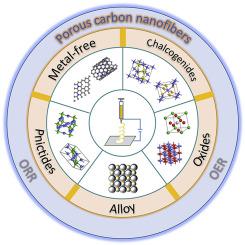Materials Today Energy ( IF 9.3 ) Pub Date : 2021-08-31 , DOI: 10.1016/j.mtener.2021.100850 Xuan Wang 1 , Xinyue Zhang 1 , Gengtao Fu 1 , Yawen Tang 1

|
Oxygen electrocatalysis including oxygen reduction reaction and oxygen evolution reaction is key to improve conversion efficiency of metal–air batteries. Noble metals are accepted for oxygen electrocatalysis, but their scarcity and poor durability largely inhibit their wide commercial application. One-dimensional (1D) porous carbon-based materials (e.g. carbon-supported transition metals and heteroatom-doped carbon) are the promising alternatives for noble metal–based catalysts, owing to more exposed active sites, high electronic conductivity, and good mechanical strength. However, achieving favorable 1D porous carbon-based materials remains a great challenge. Electrospinning technology accompanied by post-treatments (e.g. preoxidation and annealing) is considered to be a facile and universal strategy for the preparation of porous carbon-based nanofibers. This review focuses on recent progress in designing of porous carbon-based nanofibers via electrospinning technology for oxygen electrocatalysis. A brief introduction of the electrospinning principles is provided and discussed firstly. Then, a classified introduction and discussion of electrospun porous carbon-based nanofibers in terms of preparation and application in oxygen electrocatalysis is highlighted. Finally, the current challenges and future perspectives on the synthesis and electrocatalytic applications of electrospun porous carbon-based nanofibers are proposed.
中文翻译:

电纺多孔碳基纳米纤维用于氧电催化的研究进展
氧电催化包括氧还原反应和析氧反应是提高金属-空气电池转换效率的关键。贵金属被接受用于氧电催化,但它们的稀缺性和耐久性差在很大程度上阻碍了其广泛的商业应用。一维(1D)多孔碳基材料(例如碳负载过渡金属和杂原子掺杂碳)是贵金属基催化剂的有前途的替代品,因为它具有更多暴露的活性位点、高电子电导率和良好的机械强度. 然而,获得有利的一维多孔碳基材料仍然是一个巨大的挑战。伴随后处理(例如预氧化和退火)的静电纺丝技术被认为是制备多孔碳基纳米纤维的简便且通用的策略。本综述重点介绍了通过静电纺丝技术设计用于氧电催化的多孔碳基纳米纤维的最新进展。首先提供并讨论了静电纺丝原理的简要介绍。然后,重点介绍和讨论了电纺多孔碳基纳米纤维在氧电催化中的制备和应用。最后,提出了电纺多孔碳基纳米纤维的合成和电催化应用的当前挑战和未来前景。重点介绍和讨论了电纺多孔碳基纳米纤维在氧电催化中的制备和应用。最后,提出了电纺多孔碳基纳米纤维的合成和电催化应用的当前挑战和未来前景。重点介绍和讨论了电纺多孔碳基纳米纤维在氧电催化中的制备和应用。最后,提出了电纺多孔碳基纳米纤维的合成和电催化应用的当前挑战和未来前景。


























 京公网安备 11010802027423号
京公网安备 11010802027423号